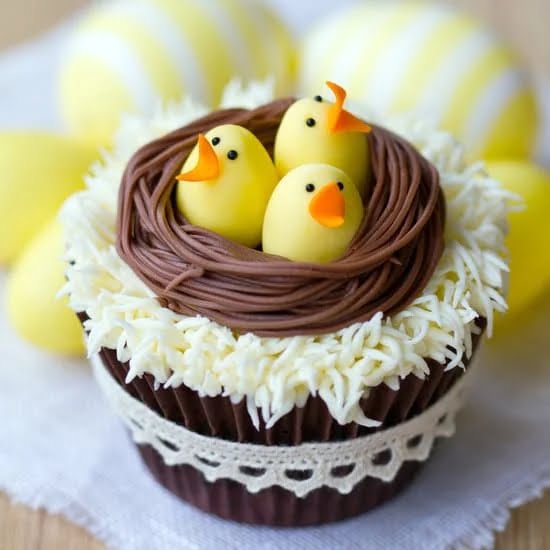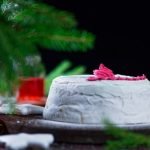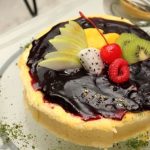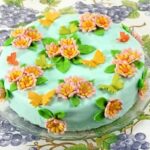Royal icing is a versatile and durable medium that can elevate the visual appeal of any cake. In this article, we will explore the art of creating stunning royal icing decorations on cakes. Whether you’re a professional baker or a passionate home baker, understanding royal icing and its properties is essential for achieving beautiful and intricate designs.
Royal icing is a type of icing made from egg whites and powdered sugar, resulting in a smooth and glossy texture when dried. What sets royal icing apart from other icings is its ability to harden completely, making it perfect for intricate decorations that require structure and durability. It acts as both an adhesive and sculpting medium, allowing bakers to create detailed designs on their cakes.
The versatility of royal icing is unmatched when it comes to cake decorations. It can be piped, molded, and painted to create various designs, ranging from delicate lace patterns to intricate floral motifs. Not only does royal icing provide endless possibilities for creativity, but it also ensures that your cake decorations remain intact until they are ready to be enjoyed.
Getting Started
Tools for Working with Royal Icing
Before diving into the world of royal icing decorations, it’s essential to have the right tools and equipment on hand. Here are some must-have items that will help you create stunning designs:
- Piping Bags: These disposable or reusable bags are designed for holding and dispensing royal icing. Opt for sturdy piping bags that offer control and precision while decorating.
- Decorating Tips: Different tips create different shapes and effects when piping royal icing. The most commonly used tips for cake decorations include round tips (for outlining and fine details), star tips (for creating borders and rosettes), and petal tips (for flower designs).
- Couplers: Couplers allow you to switch between decorating tips without changing the piping bag, making it easy to try different designs quickly.
- Parchment Paper or Wax Paper: Having a good supply of parchment or wax paper is crucial for practicing piping techniques, creating templates, and drying your royal icing decorations.
Ingredients for Making Royal Icing
To make your own royal icing, you’ll need just a few ingredients that are easily accessible:
- Confectioners’ Sugar (Icing Sugar): This finely ground sugar dissolves easily in the icing mixture, resulting in a smooth texture.
- Egg Whites or Meringue Powder: Traditionally, royal icing is made with raw egg whites to achieve its classic consistency. However, meringue powder is a safe alternative made from dried egg whites, sugar, stabilizers, and flavorings.
- Lemon Juice or Cream of Tartar: These acidic ingredients help stabilize the egg whites and prevent overbeating.
- Flavorings: While not necessary, adding vanilla extract or other flavorings like almond extract can enhance the taste of your royal icing.
- Water: Used to thin down the icing if necessary or adjust the consistency for different techniques.
Remember to have all your tools and ingredients neatly organized before starting your royal icing decorations. This preparation will ensure a smoother decorating process and more polished results. With these essential tools at hand, you are now ready to embark on your royal icing decoration journey.
Mastering the Techniques
Creating stunning royal icing decorations requires a mastery of techniques that allow you to achieve the perfect consistency, execute intricate designs, and add texture to your creations. With the following tips and tricks, you can elevate your cake decorations and impress everyone with your skill and creativity.
1. Achieving the Perfect Consistency:
The consistency of royal icing is crucial for creating clean lines and smooth finishes. To achieve the ideal consistency, start by using fresh ingredients and sift your powdered sugar to remove any lumps. Gradually add water or liquid (such as lemon juice or egg whites) to your icing mix while whisking continuously until it reaches your desired consistency. It should be thick enough to hold its shape when piped but thin enough to flow smoothly.
2. Piping Techniques:
Piping is a fundamental skill in royal icing decoration. The outlining technique involves piping a border around the design to create definition and keep the flood icing contained within it. Use a thin piping tip for fine detailing or a larger one for bolder outlines.
Flooding is another technique where you fill in larger areas with thinned royal icing for a smooth finish. Carefully pipe the flood icing within the outlined borders, using a toothpick or scribe tool to spread it evenly if needed.
Layering is another useful technique that allows you to create dimension by building up multiple layers of royal icing on top of each other.
3. Adding Texture:
Texture can bring depth and visual interest to your royal icing decorations. You can achieve this by using different piping tips or applying various techniques such as dotting, dragging, or stippling with a brush or toothpick onto freshly piped royal icing. Experimenting with different textures can give your decorations a unique look and enhance their overall appearance.
By applying these tips and tricks, you can take your royal icing decorations to new heights of creativity and skill. Remember to practice and experiment with different techniques to find your own unique style. With patience and dedication, you’ll create stunning royal icing decorations that will impress anyone who sees your beautifully decorated cakes.
Exploring Different Royal Icing Decoration Styles
Royal icing is a versatile medium that allows for a wide range of decoration styles on cakes. From delicate lace patterns to intricate floral designs, the possibilities are endless when it comes to creating stunning royal icing decorations. In this section, we will explore different decoration styles that can be achieved with royal icing and provide inspiration for incorporating them into various cake themes.
One popular style of royal icing decoration is lace patterns. This delicate and intricate design can add an elegant touch to any cake. Lace patterns are created by piping fine lines and intricate designs onto a smooth surface, allowing the cake to show through. This technique requires a steady hand and precision, as even the slightest mistake can disrupt the lace pattern. However, with practice and patience, you can achieve beautifully detailed lace designs that will impress your guests.
Floral designs are another popular choice for royal icing decorations. Whether you want to create lifelike roses or a garden of blooming flowers, royal icing provides the perfect medium for achieving realistic floral effects on your cakes. With piping techniques such as layering and flooding, you can create multidimensional flowers with beautiful texture and depth.
In addition to lace patterns and floral designs, royal icing also allows for intricate detailing on cakes. From monograms and filigree to scrollwork and borders, there are countless ways to incorporate detailed elements into your cake designs using royal icing. The key is to have a steady hand and practice patience as you pipe these intricate details onto your cakes.
To get started with exploring different royal icing decoration styles, gather inspiration from online platforms like Pinterest or Instagram. You’ll find a wealth of ideas and examples that will spark your creativity. Experiment with different piping techniques, colors, and designs until you find your own unique style.
| Decoration Style | Description |
|---|---|
| Lace Patterns | Delicate and intricate designs that resemble lace fabric. |
| Floral Designs | Realistic flowers created with layering and flooding techniques. |
| Intricate Detailing | Monograms, filigree, scrollwork, and borders that add refined detailing to cakes. |
Troubleshooting Guide
Working with royal icing can sometimes pose challenges, but with a little troubleshooting, you can easily overcome common issues that may arise. In this section, we will address some of the most common problems that users encounter when working with royal icing and provide practical solutions to fix them.
One common issue that decorators face is achieving the right consistency of royal icing. If your icing is too thick, it can be difficult to pipe intricate designs, while if it’s too thin, it may spread and lose definition.
To fix this problem, you can adjust the consistency by adding more powdered sugar to thicken the icing or adding small amounts of water to thin it out. It’s important to make these adjustments gradually and test the consistency as you go until you achieve the desired thickness.
Another challenge that can occur is air bubbles forming in your royal icing while piping or flooding. These bubbles can ruin the smooth finish of your decorations. To minimize air bubbles, always tap your decorating bag gently on the table before piping and use a toothpick or scribe tool to pop any visible bubbles on the surface. You can also try running a toothpick through your flooded area in a zigzag motion to release trapped air pockets.
Smudging is yet another issue that may occur when working with royal icing decorations, especially if you’re layering different colors or designs. To prevent smudging, make sure each layer is fully dry before applying another layer on top. Patience is key here – rushing the drying process may result in unwanted smudges.
If smudging does occur, don’t worry. You can carefully scrape off the smudged area using a toothpick or small spatula and allow it to fully dry before trying again.
By understanding these common challenges and knowing how to solve them, you’ll be better equipped to create beautiful royal icing decorations without any frustration along the way. With a bit of practice and these troubleshooting tips, you’ll be able to achieve impressive results with your royal icing cake decorations.
Adding Finishing Touches
When it comes to royal icing decorations on cakes, there are endless possibilities for adding that extra touch of visual appeal. One of the most exciting parts of working with royal icing is the opportunity to customize and personalize your creations. In this section, we will explore various methods for painting, coloring, and embellishing royal icing decorations, allowing you to take your cake designs to the next level.
Painting Techniques
Painting royal icing decorations can add depth and dimension to your designs. With the right tools and techniques, you can achieve stunning effects that enhance the overall look of your cake. One popular method is using edible food coloring mixed with a clear alcohol or lemon extract to create a paint-like consistency.
This allows for smooth brush strokes and easy application on the decorations. Another technique is airbrushing, which gives a professional and seamless finish by using an airbrush machine to spray color onto the decorations.
Coloring Royal Icing
Coloring royal icing opens up a whole world of creative possibilities. By simply adding food coloring to your base icing recipe, you can achieve any hue you desire. It is important to use gel-based food coloring rather than liquid drops as it won’t water down the consistency of your icing. Start by adding a small amount of coloring and gradually build up until you reach your desired shade.
Embellishments
Edible embellishments are another fantastic way to enhance royal icing decorations on cakes. Edible pearls can be delicately placed onto buttercream flower centers or used as borders around cake tiers for an elegant finish.
Lustre dust adds a beautiful shimmer effect, creating eye-catching highlights on petals or intricate details. For those looking for an extra touch of luxury, edible gold leaf can be carefully applied onto certain areas with a soft brush, instantly elevating the overall look of your cake.
By exploring different painting techniques and adding color and embellishments to your royal icing decorations, you can truly make your cakes stand out. These finishing touches provide an opportunity for self-expression and creativity while taking your cake decorating skills to new heights. The possibilities are endless, so don’t be afraid to experiment and let your imagination run wild.
Royal Icing Storage and Preservation
After putting in the time and effort to create beautiful royal icing decorations for your cakes, you’ll want to make sure they stay fresh and long-lasting. Proper storage and preservation techniques are key to maintaining the quality of your decorations. Here are some guidelines to help you keep your royal icing creations in pristine condition:
- Allow Adequate Drying Time: Before storing your royal icing decorations, it’s important to let them dry completely. This ensures that they harden and become more durable, making them less prone to breakage or smudging during storage. The drying time will vary depending on the size and thickness of your decorations, so be sure to plan ahead and allow sufficient drying time.
- Store in an Airtight Container: Once dry, place your royal icing decorations in an airtight container or storage bag. This helps protect them from moisture, humidity, and air exposure, which can cause the decorations to become soft or lose their shape over time.
- Choose a Cool and Dry Storage Location: It’s crucial to store royal icing decorations in a cool and dry place as heat and humidity can adversely affect their stability. Avoid storing them near windows or areas with direct sunlight, as sunlight can fade the colors of the decorations.
- Layer Separately: If you need to stack multiple layers of decorations, ensure that each layer is separated by parchment paper or wax paper. This prevents any potential damage caused by sticking together or weight from one layer crushing another.
- Use Silica Gel Packs: To further protect your royal icing creations from moisture, consider adding silica gel packs inside the storage container. Silica gel absorbs excess moisture in the air and helps preserve the crispness of the decorations.
By following these storage guidelines, you can extend the longevity of your royal icing decorations and enjoy their beauty for longer periods of time. Taking the necessary steps to store and preserve your creations will ensure that they remain fresh, intact, and ready to be showcased on your next cake.
Showcase
One of the most exciting aspects of working with royal icing is the endless creativity and possibilities it offers for decorating cakes. From delicate lace patterns to intricate floral designs, royal icing can be used to create stunning decorations that will leave everyone in awe. In this section, we will showcase some impressive examples of cake designs that incorporate royal icing decorations.
1. Lace Patterns:
Using royal icing, bakers can achieve exquisite lace patterns that add a touch of elegance and sophistication to any cake. Whether it’s a vintage-inspired wedding cake or a romantic anniversary cake, lace patterns created with royal icing are sure to impress. Intricate details and delicate motifs can be created with the help of piping techniques such as outlining and flooding. The intricate nature of these designs requires precision and patience, but the end result is truly breathtaking.
2. Floral Designs:
Another popular style when it comes to royal icing decorations is floral designs. The versatility of royal icing allows for the creation of lifelike flowers that can make any cake come alive. From roses and hydrangeas to daisies and peonies, these edible floral arrangements add a touch of beauty and freshness to your cake design. With various piping tips and techniques such as layering and adding texture, you can create realistic petals, leaves, and even delicate flower centers.
3. Intricate Detailing:
For those who love intricate detailing on their cakes, using royal icing opens up a world of possibilities. From ornate filigree patterns to delicate monograms or personalized messages, there is no limit to what you can create with royal icing. By mastering piping techniques such as fine lines and brush embroidery, you can add intricate details that will wow your guests.
Conclusion
Royal icing is truly a game-changer when it comes to cake decorations. Its versatility and durability make it the perfect choice for creating stunning designs on cakes of all kinds. Whether you’re going for a classic, elegant look or a fun and whimsical design, royal icing can help you achieve your desired results.
With the right tools and ingredients, anyone can master the art of royal icing decorations. From piping bags and tips to food coloring and edible embellishments, having the essential supplies at hand will ensure that you’re well-equipped to bring your creative vision to life. And with step-by-step instructions and helpful tips, you’ll be able to achieve the perfect consistency for your royal icing and create beautiful designs with ease.
The beauty of royal icing lies in its ability to showcase various decoration styles. Whether you want delicate lace patterns, intricate floral designs, or bold and detailed decorations, royal icing can handle it all. It allows you to add texture and depth to your creations, making them truly one-of-a-kind masterpieces. No matter what theme or occasion you have in mind, royal icing decorations can take your cake from ordinary to extraordinary.
In conclusion, working with royal icing opens up a world of possibilities for cake decorating enthusiasts. Its versatility, durability, and endless design options make it an ideal choice for elevating your cake decorations and impressing guests with your artistic skills. So go ahead – grab those piping bags and ingredients, unleash your creativity, and let royal icing take your cake decorations to new heights.
Frequently Asked Questions
Can you use royal icing to decorate a cake?
Yes, royal icing can be used to decorate a cake. Royal icing is a popular choice for creating intricate designs and decorations on cakes because of its smooth texture and ability to harden when it dries.
Many bakers use royal icing to pipe borders, flowers, or intricate patterns onto the surface of the cake. It can also be used to create a smooth finish on the top of the cake or to cover cupcakes and cookies.
Can I make royal icing decorations in advance?
Absolutely! Making royal icing decorations in advance is a common practice among bakers. One of the advantages of royal icing is that it has a long shelf life when properly stored.
You can make your decorations well in advance, allowing ample time for them to fully dry and harden before they are used on the cake. Once dried, these decorations can be stored in an airtight container until you’re ready to use them.
How do you attach decorations to an iced cake?
Attaching decorations to an iced cake requires careful handling and consideration of both the type of decoration and the type of frosting being used. For lightweight edible decorations such as royal icing flowers or fondant cut-outs, you can simply apply a small dab of additional icing or frosting onto the back of the decoration before placing it on the desired spot on the cake.
Gently press it down to secure it in place.

Welcome to our cake decorating blog! My name is Destiny Flores, and I am the proud owner of a cake decorating business named Cake Karma. Our mission is to provide delicious, beautiful cakes for all occasions. We specialize in creating custom cakes that are tailored specifically to each customer’s individual needs and tastes.





